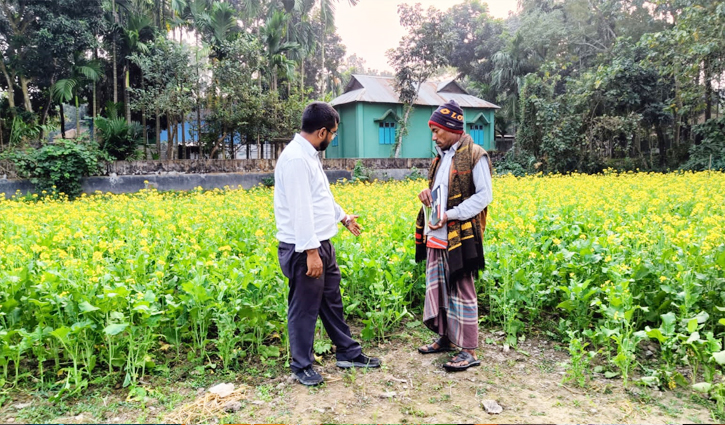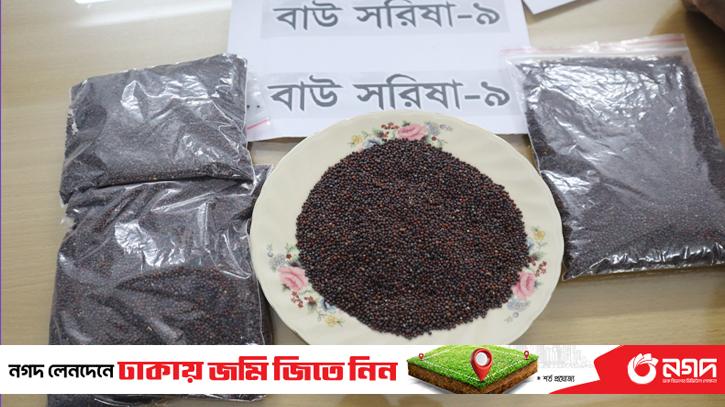A group of researchers from Bangladesh Agricultural University (BAKRBI) has developed a new mustard variety with short duration, high yield, disease resistance and salinity tolerance. The newly developed variety has been named Bau Mustard-9. Which got registration from National Seed Board on March 31 this year.
The production period of this new variety is 78 to 82 days and the oil content of the seeds is 42.5 percent, which is about 30-35 percent of the common mustard varieties in the country. 1 liter of oil can be obtained from 2.5 kg of mustard from the developed variety. The yield of the variety is about 2 tons per hectare which is about 20-25 percent higher than other conventional short duration mustard varieties.
In a press conference organized on the occasion of the release of the invented Bau Mustard-9, the inventor and chief researcher of the breed said this information. A. B. M. Arif Hasan Khan Robin. In addition, there were several postgraduate and PhD students of that department as research assistants. On Wednesday (April 24) at 10 am, the press conference was organized in the office room of the researcher in the Department of Aesthetics and Plant Breeding.
In the press conference, the researcher said that in the case of Bau Mustard-9 cultivation, we have seen that the attack of Alternaria blight, insects and diseases is very less. As the variety is moderately flood and salinity tolerant, the yield is about 20-25 percent higher than other conventional varieties. Experimental cultivation of the variety in Kishoreganj, Gazipur, Research Field of Aesthetics and Plant Breeding and Char area of Brahmaputra River near Bakribi has yielded as expected.

He said that the oleic acid content of the invented Bau mustard-9 is 16-17 percent, the proportion of omega-6 and omega-3 fatty acids is 25:1, which is 18:1 in soybean oil. The smoke point of oil obtained from Bau Mustard-9 is 250 degrees Celsius, which is about 14 degrees higher than that of soybean oil. Glucosinolate present in mustard oil is broken down to form isothiocyanate, which is anti-cancer. As a result, as an edible oil, Bau Sarisa-9 mustard oil is more healthy than soybean oil.
He also said that mustard is cultivated in about 1 million hectares of land in the country. The total market value of mustard oil produced is about 3 thousand crore rupees. This production can meet only 20-30 percent of the country's total edible oil demand. Because of this every year 20 to 22 thousand crore rupees of mustard, soybean and palm oil have to be imported. Bangladesh government has set a target of meeting 40 percent edible oil demand by increasing production in domestic processes. In such a situation, it will be possible to meet the country's edible oil demand and earn foreign exchange by cultivating Bau Mustard-9 variety.
The researcher said that compared to other common mustard varieties, cultivation of Bau Sarisa-9 will yield about 24,000 taka more profit per hectare. According to that, it is possible to create a mustard market worth 24 billion rupees annually. Also, as the variety is short-duration, it can be cultivated between Aman and Boro rice. As a result, it will be possible to produce four crops a year on the same land which will also increase cropping intensity.

About the invented variety, the researcher said, Bau Mustard-9 is a Brassica napus species with an average lifespan of 80 days. Among the more than 250 genotypes stored in the Department of Quality and Plant Breeding, five short-lived genotypes were selected species-wise. Later, the short-lived species Bau Sarisa-9 was developed by advanced research on dialal mating method of genotypes.
It is known that under the three projects of Bangladesh Agricultural University Research System (BAURES), this variety has been researched for seven years since 2018. The three projects are Germplasm Enhancement and Genetic Purity for Biotic Stress Resistance and Short Duration in Rapeseed and Mustard, Dialal Mating in Well Seeded Brassica Genotypes to Select for Short Duration and Abiotic Stress Tolerance Lines from F-2 Population and Selection for Short Duration, Alternaria Blight and Salinity Stress Tolerance in the Advanced Breeding Lines of Rapeseed and Mustard.
The project related research papers have been published in reputed impact factor journals and several research papers are under process for publication. At present, higher research is going on for further improvement of the breed and development of several new breeds is in process.



